Hashing in Data Structure-
Before you go through this article, make sure that you have gone through the previous article on Hashing.
We have discussed-
- Hashing is a well-known searching technique.
- It minimizes the number of comparisons while performing the search.
- It completes the search with constant time complexity O(1).
In this article, we will discuss about Collisions in Hashing.
Collision in Hashing-
In hashing,
- Hash function is used to compute the hash value for a key.
- Hash value is then used as an index to store the key in the hash table.
- Hash function may return the same hash value for two or more keys.
| When the hash value of a key maps to an already occupied bucket of the hash table,
it is called as a Collision. |
Collision Resolution Techniques-
| Collision Resolution Techniques are the techniques used for resolving or handling the collision. |
Collision resolution techniques are classified as-
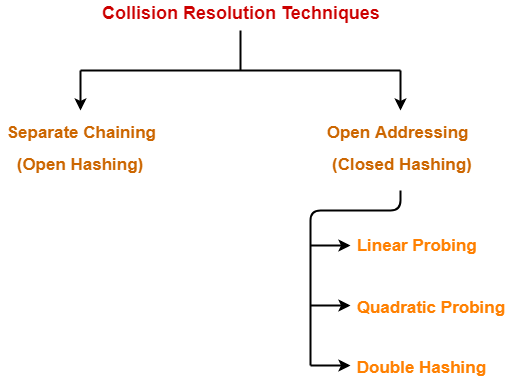
- Separate Chaining
- Open Addressing
In this article, we will discuss about separate chaining.
Separate Chaining-
To handle the collision,
- This technique creates a linked list to the slot for which collision occurs.
- The new key is then inserted in the linked list.
- These linked lists to the slots appear like chains.
- That is why, this technique is called as separate chaining.
Time Complexity-
For Searching-
- In worst case, all the keys might map to the same bucket of the hash table.
- In such a case, all the keys will be present in a single linked list.
- Sequential search will have to be performed on the linked list to perform the search.
- So, time taken for searching in worst case is O(n).
For Deletion-
- In worst case, the key might have to be searched first and then deleted.
- In worst case, time taken for searching is O(n).
- So, time taken for deletion in worst case is O(n).
Load Factor (α)-
Load factor (α) is defined as-

If Load factor (α) = constant, then time complexity of Insert, Search, Delete = Θ(1)
PRACTICE PROBLEM BASED ON SEPARATE CHAINING-
Problem-
Using the hash function ‘key mod 7’, insert the following sequence of keys in the hash table-
50, 700, 76, 85, 92, 73 and 101
Use separate chaining technique for collision resolution.
Solution-
The given sequence of keys will be inserted in the hash table as-
Step-01:
- Draw an empty hash table.
- For the given hash function, the possible range of hash values is [0, 6].
- So, draw an empty hash table consisting of 7 buckets as-
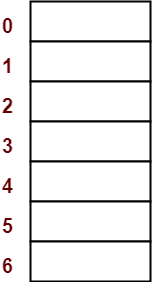
Step-02:
- Insert the given keys in the hash table one by one.
- The first key to be inserted in the hash table = 50.
- Bucket of the hash table to which key 50 maps = 50 mod 7 = 1.
- So, key 50 will be inserted in bucket-1 of the hash table as-
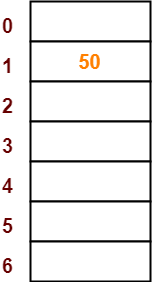
Step-03:
- The next key to be inserted in the hash table = 700.
- Bucket of the hash table to which key 700 maps = 700 mod 7 = 0.
- So, key 700 will be inserted in bucket-0 of the hash table as-
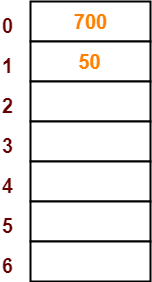
Step-04:
- The next key to be inserted in the hash table = 76.
- Bucket of the hash table to which key 76 maps = 76 mod 7 = 6.
- So, key 76 will be inserted in bucket-6 of the hash table as-
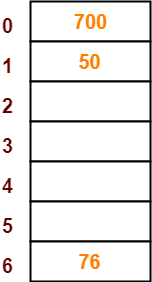
Step-05:
- The next key to be inserted in the hash table = 85.
- Bucket of the hash table to which key 85 maps = 85 mod 7 = 1.
- Since bucket-1 is already occupied, so collision occurs.
- Separate chaining handles the collision by creating a linked list to bucket-1.
- So, key 85 will be inserted in bucket-1 of the hash table as-
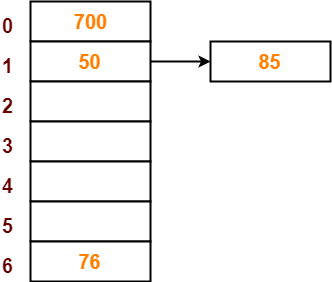
Step-06:
- The next key to be inserted in the hash table = 92.
- Bucket of the hash table to which key 92 maps = 92 mod 7 = 1.
- Since bucket-1 is already occupied, so collision occurs.
- Separate chaining handles the collision by creating a linked list to bucket-1.
- So, key 92 will be inserted in bucket-1 of the hash table as-
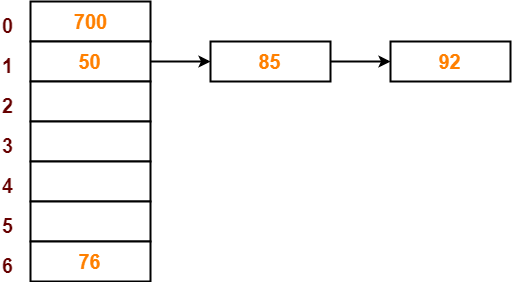
Step-07:
- The next key to be inserted in the hash table = 73.
- Bucket of the hash table to which key 73 maps = 73 mod 7 = 3.
- So, key 73 will be inserted in bucket-3 of the hash table as-
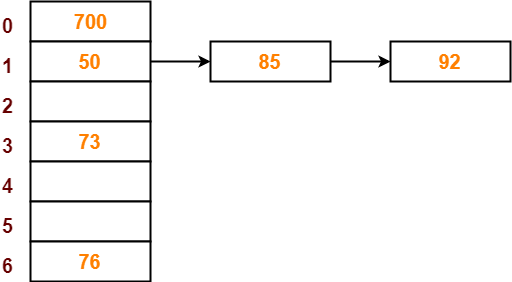
Step-08:
- The next key to be inserted in the hash table = 101.
- Bucket of the hash table to which key 101 maps = 101 mod 7 = 3.
- Since bucket-3 is already occupied, so collision occurs.
- Separate chaining handles the collision by creating a linked list to bucket-3.
- So, key 101 will be inserted in bucket-3 of the hash table as-
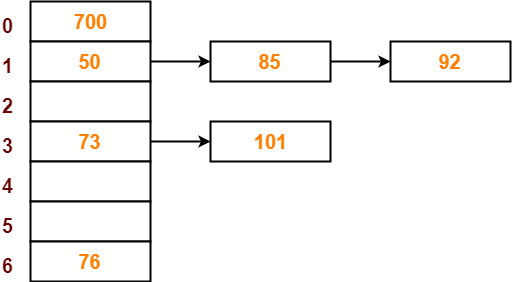
To gain better understanding about Separate Chaining,
Next Article- Open Addressing
Get more notes and other study material of Data Structures.
Watch video lectures by visiting our YouTube channel LearnVidFun.

